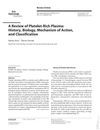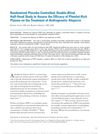TLDR PRP therapy has evolved over 70 years and is used for healing and cosmetic purposes, but its effectiveness varies.
Platelet-rich plasma (PRP) therapy, with a 70-year history, began in transfusion medicine and has expanded into fields like regenerative and esthetic dermatology, particularly for hair and scalp conditions. It is used for tissue regeneration, wound healing, scar revision, skin rejuvenation, and alopecia. Recent advancements include growth factor concentrate (GFC) and exosome-rich formulations to enhance regenerative potential. However, evidence of PRP's efficacy varies across applications, with some areas showing more promising results than others.
 February 2024 in “Folia Medica”
February 2024 in “Folia Medica” Platelet-rich plasma treatment is effective for hair loss in patients regardless of their thyroid antibody levels.
10 citations
,
March 2021 in “Annals of palliative medicine” PRP shows promise in healing but needs a standardized, safe preparation method.
 348 citations
,
July 2017 in “Skin appendage disorders”
348 citations
,
July 2017 in “Skin appendage disorders” Platelet-rich plasma shows promise for skin and hair treatments but needs more research and standardization.
 136 citations
,
April 2016 in “Dermatologic Surgery”
136 citations
,
April 2016 in “Dermatologic Surgery” PRP treatment helps hair growth and density in androgenetic alopecia patients.
4 citations
,
March 2022 in “Pharmaceutics” Regenerative cellular therapies show promise for treating non-scarring hair loss but need more research.
 June 2025 in “Dermatologic Surgery”
June 2025 in “Dermatologic Surgery” GFC improves hair quickly, while PRP offers longer-lasting benefits; using both sequentially is recommended.
 October 2025 in “Asian Journal of Oral Health and Allied Sciences”
October 2025 in “Asian Journal of Oral Health and Allied Sciences” Autologous growth factor concentrate therapy shows promise for treating early-stage hair loss safely and effectively.
 April 2025 in “Journal of Cosmetic and Laser Therapy”
April 2025 in “Journal of Cosmetic and Laser Therapy” QR678 Neo® improves hair transplant success and hair regrowth.
 3 citations
,
November 2021 in “Clinical, Cosmetic and Investigational Dermatology”
3 citations
,
November 2021 in “Clinical, Cosmetic and Investigational Dermatology” Platelet-Rich Plasma may improve skin health and reduce wrinkles, but more research is needed for standard treatment guidelines.








